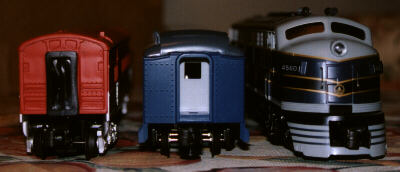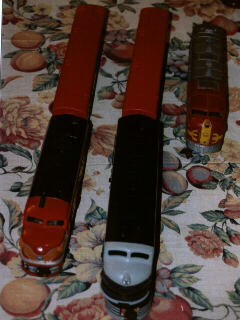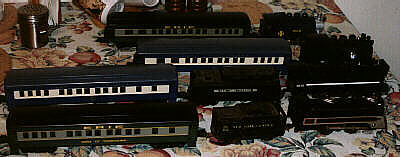Photographs, text and html copyright 2000 T. Sheil & A. Sheil All
Rights Reserved
Car Comparisons
Matching Passenger cars with Motive Power
Passenger cars sizes range from the old, extra small Marx and Lionel O27
Streamliners to long Scale Heavyweights. Because of their extreme length,
a pike's curves will be the major factor in deciding what runs and what does
not. This problem was first encountered in the 1930s, when Scale fans
decried the truncated wagons common to tinplate. In the 1940s, various
attempts were made to solve the problem of long cars on 31 and O27 track.
The added focus on realism in the Postwar years demanded new solutions.
Lionel started the ball rolling with the Madison car, a shorter,
lower-profile version of the classic 72' and 80' heavyweights. They
followed this with 12" O27 Streamliners. Marx also produced tiny
Streamliners during those years. The entry of other makers in the last
two decades has increased the options for non-scale O passenger cars.
Likewise, Scale fans are being accommodated with 1/48 heavyweight and
Streamliner type cars.
The motive power has remained pretty much standardized as it had been
in the Postwar years. Lionel produced semi-scale and O27 steamers in
abundance, with only one major O27 diesel, the Alco FA. Marx held on
to its 1/64 standard, with its O27 steamers and diesel fleet. The icon
of diesel was the EMD cab unit. Lionel's was the 1/48 F3, and Marx
had the 1/64 E7.
We must note how different makers have approached the problem of downsizing
passenger cars to handle O31 and O27 curves. Marx and Lionel initially
made very small non-scale models: the O27 streamliners. Madison cars
had more thought behind them, being lower in height and of shorter length,
yet retaining some of the width. The same can be said of the aluminum 15
inch Streamliners. Railking's approach was an even shorter Madison,
yet with a profile almost equal to a scale heavyweight. K-line developed
a 1/64 model that retained scale dimensions in height, length and depth.
Of the newer cars, the K-line is best suited to handle O27 curves.
Railking's Madison is fine on O27, as well, though the standard
Lionel/Williams Madisons can have a tight squeeze on O27 track. (At
this time, we have been unable to get our hands on Marx or lionel short O27
streamliners - can anybody spare some?) The Railking Madison looks
best behind a Scale F or GP, and passable with semi-scale diesel. L-line
Streamliners only look good behind semi-scale and O27 power, being dwarfed
buy even the short Scale F units. The lionel / Williams Madison works
behind almost any power, looking a bit small behind Scale and a bit wide
behind pure 1/64.
Your pike and motive power factor most in your choice of passenger cars.
Note: the standard Heavyweight, in real life, is several inches taller than
the roof of an EMD cab unit. Streamliners generally run fro ma few
inches shorter to a comparable height, while the latest commuter cars (Comets,
Horizons, bombardiers) tend to be much shorter.

Marx E7 is close to right height, and would be right length if Madison
represented O27 80' car |

Appearance of Classic F7 is passable, but a bit tall. |

Marx E7 is right size for this car, if we regard the Madison as being an
80 footer. |

F7 is too tall for the Streamliner |

Front view, L to R: K-Line Streamliner, 60' Madison and Classic F7 The
curve of the celestory might give the impression, in this photo, that the
Madison is shorter than the Streamliner. in fact. it is 1/16 to 1/8
inch taller. Originally designed for the semi-scale steamer and 1/48
F3, the Madison is notably wider than the O27 Streamliner. |
 The F7 looks too wide
for the O27 streamliner, while the FA is not as obvious. E7 for comparison. The F7 looks too wide
for the O27 streamliner, while the FA is not as obvious. E7 for comparison. |

Locomotives with Madisons - Marx 0-4-0 and Tank Engine look tiny, but the
4-4-2 looks right at home. |

From rear: Docksider w/ Heavyweight, 4-4-2 w/ Heavyweight, 0-4-0 w/ Madison
Note larger doors, etc, of Heavyweight. The 72' Scale car looks
too large when behind the semi-scale 4-4-2, 0-4-0 and 2-4-2. |
Click here to return to the All Gauge Model Railroading
Page for the best and most free resources for all scales of model
railroading.





 The F7 looks too wide
for the O27 streamliner, while the FA is not as obvious. E7 for comparison.
The F7 looks too wide
for the O27 streamliner, while the FA is not as obvious. E7 for comparison.
